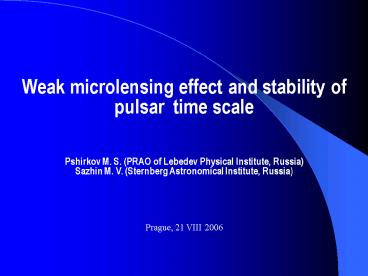Weak microlensing effect and stability of pulsar time scale - PowerPoint PPT Presentation
1 / 11
Title:
Weak microlensing effect and stability of pulsar time scale
Description:
Weak microlensing effect and stability of pulsar time scale ... The phase shift changes in time, because ? is variable ... Time of Arrival (TOA) residuals will be as: ... – PowerPoint PPT presentation
Number of Views:56
Avg rating:3.0/5.0
Title: Weak microlensing effect and stability of pulsar time scale
1
Weak microlensing effect and stability of pulsar
time scale Pshirkov M. S. (PRAO of Lebedev
Physical Institute, Russia) Sazhin M. V.
(Sternberg Astronomical Institute, Russia)
Prague, 21 VIII 2006
2
Weak microlensing effect and stability of pulsar
time scale
Schematic picture of origin of weak
microlensing effect. D-deflecting object.
3
Weak microlensing effect and stability of pulsar
time scale
Propagation of pulsar electromagnetic wave can
be described by using eikonal formalism.
Influence of gravitational deflector leads to a
small phase shift
The phase shift changes in time, because ? is
variable
4
Weak microlensing effect and stability of pulsar
time scale
Its convenient to consider this problem on the
plane of deflector then all linear measures
will be converted to angular ones. Time of
Arrival (TOA) residuals will be as
Plane of deflector
Here, q0 minimum of angular distance between
deflector and pulsar m proper motion of
deflector (relative to pulsar) t0 epoch of
the minimum distance between D and line of sight
5
Weak microlensing effect and stability of pulsar
time scale
Value q0 depends on density of population of
massive bodies (stars, MACHOs, etc.) on
celestial sphere in the pulsar neighborhood. Only
bodies between the observer and the pulsar have
to be taken into account. Therere several
millisecond pulsars in dense populated regions of
Galaxy. Lets take two of them (B193721,
J1643-1224) for further estimation. Parameters,
which are essential for estimation, are listed in
the table below.
q1 angular distance between the pulsar and the
nearest body (from accepted model of Galaxy) q0
minimum of angular distance between deflector
and pulsar (Monte-Carlo) m proper motion of
deflector (relative to pulsar) te time span of
remarkable interaction
6
Weak microlensing effect and stability of pulsar
time scale
TOA residuals, caused by the effect no fitting
conducted yet. Only trends of cubic and
higher-power orders will survive after the
fitting procedure. Linear and quadratic trends
will redefine an apparent pulsar period P and
its first derivative dP/dt.
7
Weak microlensing effect and stability of pulsar
time scale
TOA residuals due to weak microlensing effect.
The blue curve corresponds to t0 0, green one
to t050 years and red one to t0100 years. In
20 years span, TOA residuals due to the effect
accumulate 10 ns
8
Weak microlensing effect and stability of pulsar
time scale
Allan Variance (AVAR) which appears from a weak
microlensing effect.
9
Weak microlensing effect and stability of pulsar
time scale
TOA residuals due to the effect can be
significant, if q1 (angular distance between the
pulsar and the nearest body ) is much smaller
than average. The plot represents situation when
q00.1 mas. This situation has 0.5 probability
in case of B193721 this probability is much
greater for pulsars in globular clusters.
10
Weak microlensing effect and stability of pulsar
time scale
AVAR from the weak microlensing effect in
globular clusters.
11
Weak microlensing effect and stability of pulsar
time scale
Conclusions
- Average TOA residuals due to a weak
microlensing effect is about 10 ns (B193721) in
20 years span. - TOA residuals can be effectively set to zero by
using higher order terms in fitting procedure
(not for pulsars in globular clusters) - TOA residuals can be much greater if pulsar
is located in a globular cluster. - The pulsars in globular clusters cant be
recommended for using in PT scale.































